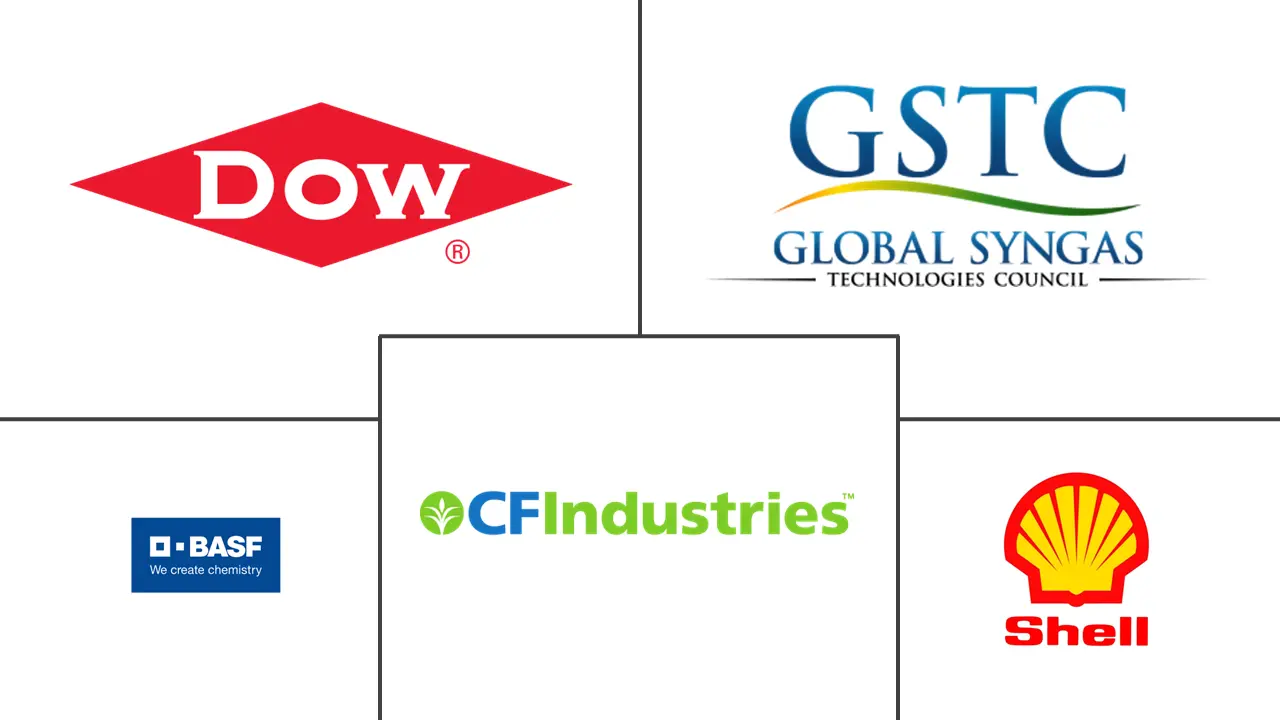Syngas Derivatives Market Size and Share
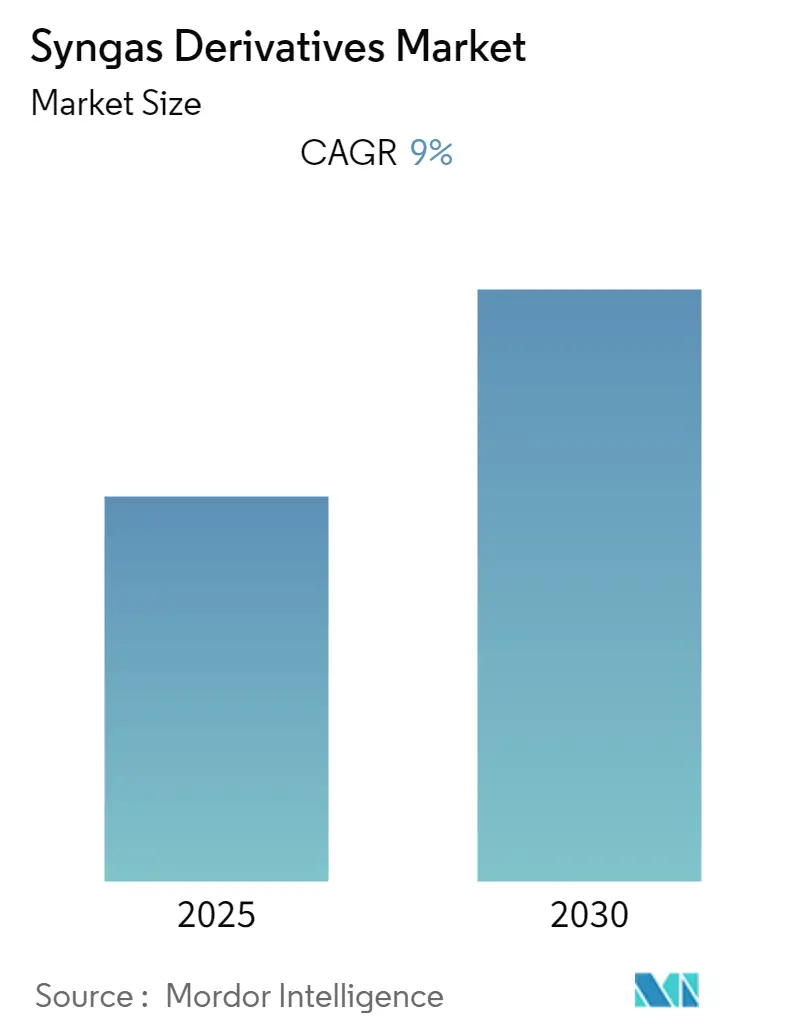
Syngas Derivatives Market Analysis by Mordor Intelligence
The Syngas Derivatives Market is expected to register a CAGR of 9% during the forecast period.
- Over the short term, growing environmental constraints and the emergence of clean technologies can be attributed to the increased demand for syngas and derivatives. Because of the high pollution levels worldwide, governments in many nations are encouraging citizens to embrace clean technologies. These concepts and activities will likely contribute to the global market's bright future in terms of growth. R&D initiatives in syngas and derivatives are also expected to help the business develop. Businesses invest considerably in R&D to increase their income. Massive investments will likely boost the global market in the long run and drive market growth during the forecast period.
- However, some impediments to syngas and derivatives market growth include substantial capital costs and the time required to build an operating plant with cutting-edge gasification techniques.
- Nevertheless, rapid urbanization, infrastructure development, and discoveries in the oil & gas industry are some significant factors contributing to cushioning overall industry growth and giving substantial potential in the forecast period.
- Regarding revenue, Asia-Pacific is expected to dominate the global market during the forecast period and includes the highest market share in the worldwide syngas derivatives market.
Global Syngas Derivatives Market Trends and Insights
Transportation Fuel include a Substantial Market Share
- During the forecast period, the transportation fuel segment is expected to rise at a CAGR of 10.3%. Power-to-liquid (PtL) fuel may emerge as a practical option as aviation moves from fossil to sustainable energies, with up to 100% reductions in greenhouse gas emissions.
- PtL fuels are created by two fundamental processes: fuel synthesis and methanol to jet. Both need synthesis gas generation, sometimes known as "syngas," a mixture of carbon monoxide and hydrogen.
- Co-electrolysis or reverse water gas shift can be used to produce syngas. The co-electrolysis process eliminates the need for separate hydrogen production. It generates syngas in a single step, whereas RWGS requires renewable or low-carbon hydrogen as a prerequisite for generating syngas.
- Suppose co-electrolysis can mature as a syngas-generation phase. In that case, it will have several advantages over RWGS, including lower levelized fuel production costs due to cost savings from the combined hydrogen and syngas production phases. Co-electrolysis include the potential to be a more efficient process due to heat recovery and integration with the fuel synthesis stage. Aside from these two approaches, several companies are experimenting with novel and potentially game-changing technology.
- Low-carbon and renewable hydrogen generation advances will also be crucial to the PtL value chain maturation. Lowering the levelized hydrogen cost to less than USD 1 per kg (including renewable energy input but excluding transport and distribution) would reduce the cost of PtL to USD 1,200 to USD 1,800 per ton, depending on the carbon source, resulting in a 40% reduction in average price by 2030. While this is still more expensive than fossil jet fuel, it is more affordable than alternative SAFs.
- Low-carbon hydrogen, often known as "blue," is mainly derived from natural gas through carbon capture and storage, whereas renewable or "green" hydrogen is derived from renewable energy. Low-carbon hydrogen is now less expensive than renewable hydrogen and can be used as a transition technology to speed up PtL scaling.
- Even though low-carbon hydrogen lowered the production costs, generating PtL requires absorbing CO2 twice: once during the hydrogen generation process and again during the fuel synthesis stage. Renewable hydrogen can be prioritized for long-term PtL production because this is inefficient.
- Rapid R&D and faster-than-anticipated cost declines for renewable energy are required today and in the future to reduce PtL input prices to less than USD 15 to USD 20 per MWh. Annual PtL jet fuel output is predicted to expand from roughly 100,000 tons announced through 2025 to ten million to 105 million tons by 2035, representing a potential thousand-fold increase within a decade. Significant capital will be necessary to meet PtL demand-possibly USD 3 trillion to USD 4 trillion between 2022 and 2050. Because of the capital intensity of PtL, investors will undoubtedly play a significant role in production expansion.
- According to British Petroleum (BP), in 2021, global oil consumption reached 94.1 million barrels per day. There was an increase of more than 6% over the previous year when worldwide oil consumption fell due to pandemic-enforced mobility limitations, which reduced transportation fuel demand.
- All the above factors will likely support the demand for the studied market in the coming years.
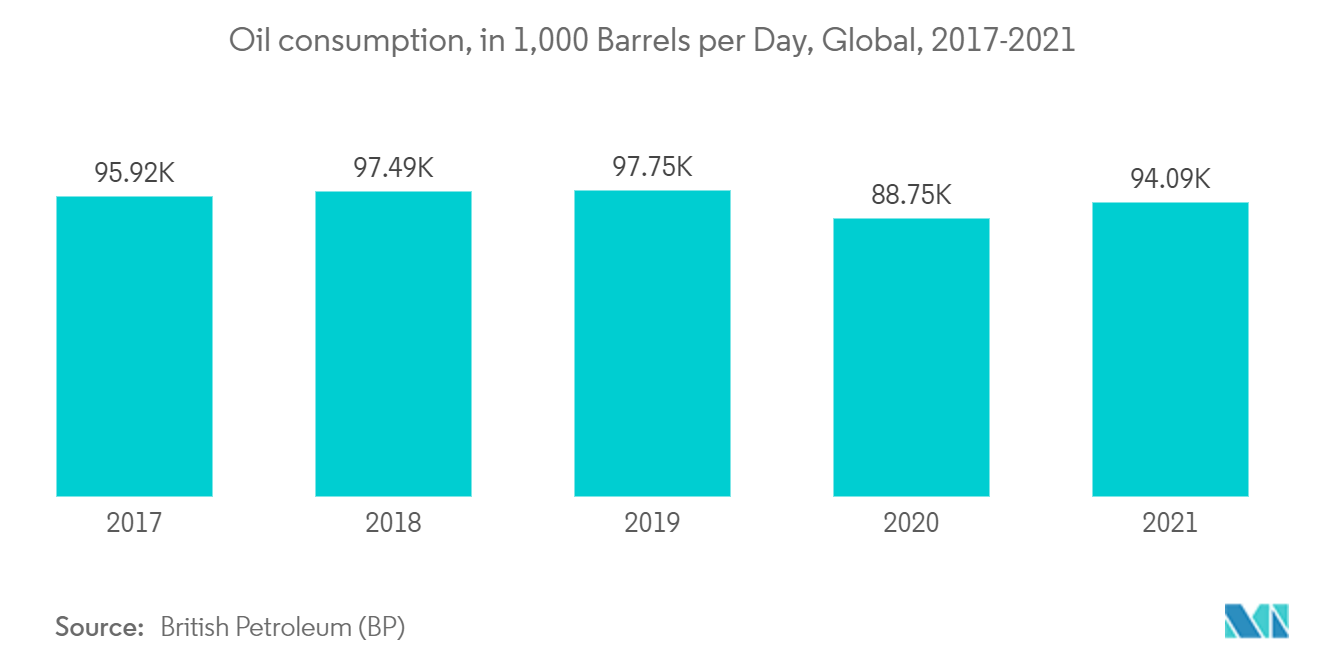
Asia-Pacific Region to Dominate the Market
- Asia-Pacific dominates the syngas derivatives market in terms of market share and market revenue. The region is set to continue its dominance over the forecast period.
- Due to the significant availability of coal and natural gas reserves, as well as expanding urbanization, infrastructure development, and discoveries in the oil and gas industry, Asia Pacific will likely maintain its leadership position in the following years.
- According to CHEManager (Chemdata International), China was the world's third-largest chemical exporting nation in 2021, accounting for 9.6% of worldwide chemical exports in terms of value.
- According to US Geological Survey, the global ammonia output in 2021 is around 150 million metric tons. East Asia produced the most ammonia, with about 64.6 million metric tons. China is the world's biggest ammonia producer. The Asian country's ammonia production was anticipated to be over 39 million metric tons of contained nitrogen in 2021. It was followed by Russia, the United States, and India, all of which produced more than 10 million tons.
- According to Annual International Trade Statistics by Country (HS), the value of imports of commodity category 290511, "Methanol (methyl alcohol)," totaled USD 3.86 billion in 2021. Sales of commodity category 290511 "Methanol (methyl alcohol)" increased by USD 1.17 billion. In 2020, the value of commodity group 290511 imports to China equaled USD 2.68 billion.
- China is currently the world's most significant hydrogen producer, with an annual output of over 33 million metric tons. On 23 March 2022, Chinese authorities issued a plan for the growth of hydrogen energy for 2021-2035 as the government works toward its carbon peaking and neutrality goals.
- According to a plan jointly released by the National Development and Reform Commission and the National Energy Administration, China will implement a relatively complete hydrogen energy industry development system by 2025. It is combined with the innovation capability significantly improved, and the core technologies and manufacturing processes essentially mastered.
- Annual hydrogen production from renewable energy is estimated to reach 100,000 to 200,000 metric tons by 2025, becoming a significant element of new hydrogen energy consumption and allowing for a 1 million to 2 million metric tons decrease in carbon dioxide emissions annually.
- China is aiming for an acceptable and orderly industrial architecture by 2030, as well as widespread usage of hydrogen generation from renewable energy, to provide firm support for the carbon peaking goal.
- According to the plan, by 2035, the share of hydrogen produced from renewable energy in terminal energy consumption will have increased dramatically, supporting the country's green energy revolution.
- Hydrogen is a secondary energy source that usually requires primary energy input to be created on a large scale. Hydrogen can be gray, blue, or green depending on its source, and green hydrogen is the only form created in a climate-neutral manner that could cut emissions.
- As a result, all the causes above are projected to increase demand for the syngas derivatives market in the Asia-Pacific region in the future.
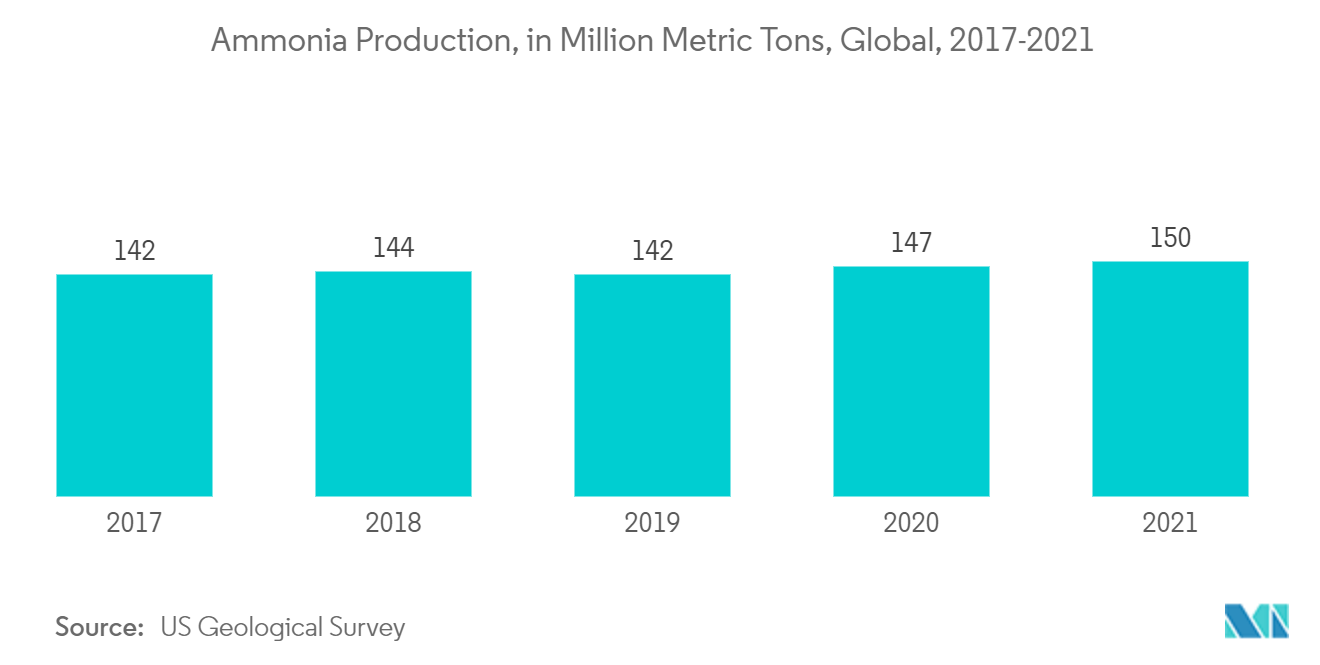
Competitive Landscape
The Syngas Derivatives Market is partially fragmented in nature. Some major manufacturers in the market include BASF SE, CF Industries Holdings, Inc., Dow Inc., Shell PLC, SynGas Technology, LLC, and others (in no particular order).
Syngas Derivatives Industry Leaders
-
BASF SE
-
CF Industries Holdings, Inc.
-
Dow Inc.
-
Shell PLC
-
SynGas Technology, LLC
- *Disclaimer: Major Players sorted in no particular order
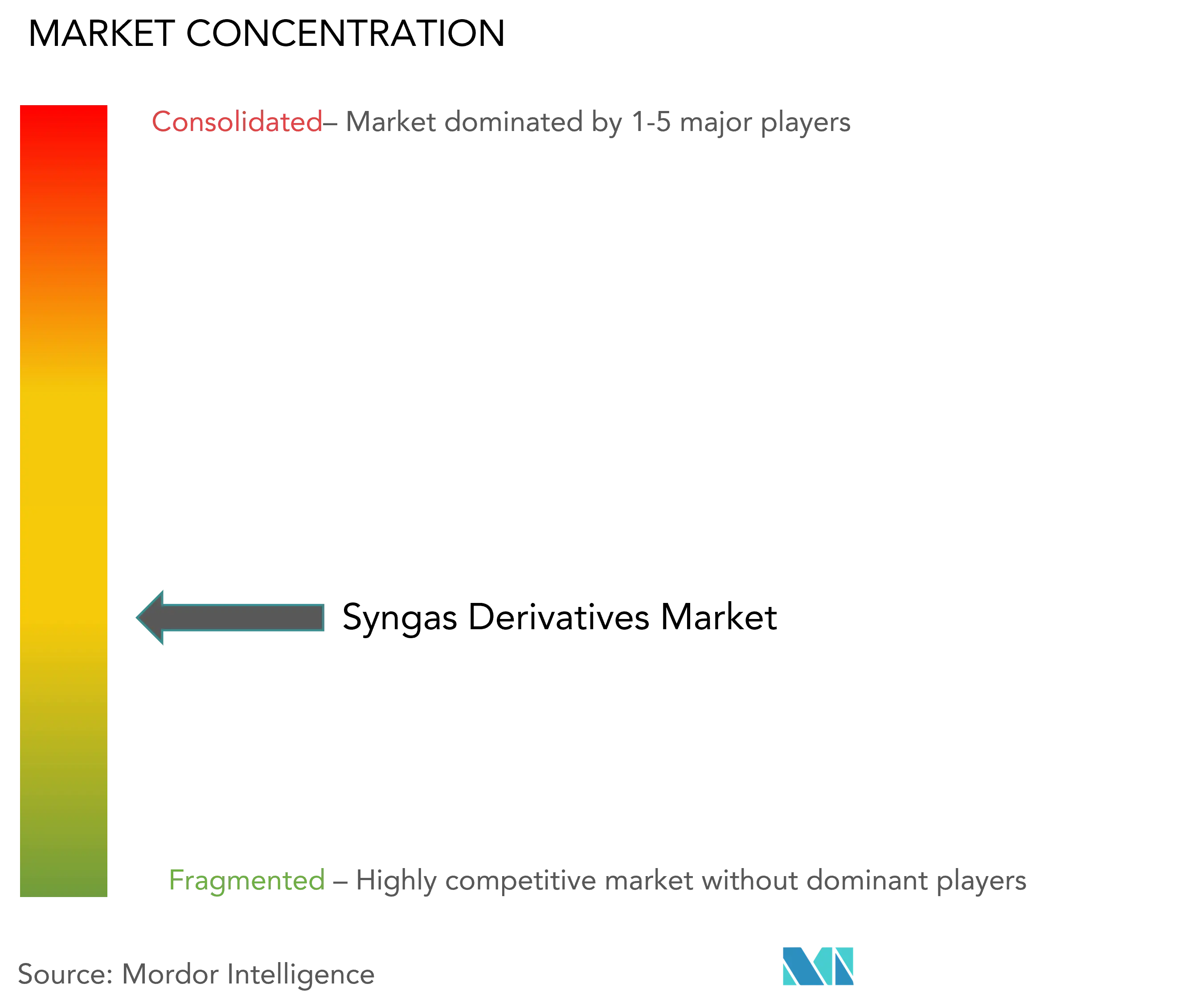
Recent Industry Developments
- October 2022: Shell and Kansai Electric Power signed an agreement to collaborate on liquid hydrogen supply chains. Shell and Kansai will research and collaborate on commercial potential in liquid hydrogen (LH2) supply chains under this Memorandum of Understanding (MoU) to enhance business decarbonization.
- July 2022: Shell began construction of Europe's largest renewable hydrogen plant. The 200 MW electrolyzer is constructed in the Tweede Maasvlakte near Rotterdam's harbor and will create up to 60,000 kilos of renewable hydrogen per day. The renewable energy for the electrolyzer came from Shell's offshore wind project Hollandse Kust (Noord).
Global Syngas Derivatives Market Report Scope
Syngas, also known as synthesis gas, synthetic gas, or production gas, is a mixture of hydrogen, carbon monoxide, and, more frequently than not, carbon dioxide. It is mainly used as a fuel and in producing other compounds. Syngas is utilized extensively in the chemical, power generating, liquid fuel, and gaseous fuel industries and is made from various carbon-containing materials. Examples include biomass (wood gas), petroleum, polymers, coal, municipal garbage, and similar materials. The growing need to reduce fossil fuel dependency due to scarcity is a significant growth factor for the syngas and derivatives sector. Primary constituents, derivatives, applications, end-user industry, and geography segment the syngas derivatives market. By primary constituents, the market is segmented into methanol, dimethyl ether, ammonia, oxo chemicals, and hydrogen. By derivatives, the market is segmented into formaldehyde, methanol-to-olefins (MTO)/methanol-to-propylene (MTP), methyl tert-butyl ether (MTBE)/ tertiary amyl methyl ether (TAME), dimethyl terephthalate (DMT), acetic Acid, dimethyl ether (DME), and methyl methacrylate (MMA). By application, the market is segmented into aerosol products, LPG blending, power generation, transportation fuel, acrylates, glycol ethers, acetates, lubes, resins, and other applications. By end-user industry, the market is segmented into agriculture, textiles, mining, pharmaceutical, refrigeration, chemicals, transportation, energy, refining, welding and metal fabrication, and other end-user Industries. The report covers the market size and forecast for the syngas derivatives market in 15 countries across major regions. For each segment, the market sizing and forecasts have been done based on value (USD million) and volume (tons) for all the above details.
| Methanol |
| Dimethyl Ether |
| Ammonia |
| Oxo Chemicals |
| Hydrogen |
| Formaldehyde |
| Methanol-to-olefins (MTO)/Methanol-to-Propylene (MTP) |
| Methyl Tert-butyl Ether (MTBE)/ Tertiary Amyl Methyl Ether (TAME) |
| Dimethyl Terephthalate (DMT) |
| Acetic Acid |
| Dimethyl Ether (DME) |
| Methyl Methacrylate (MMA) |
| Aerosol Products |
| LPG Blending |
| Power Generation |
| Transportation Fuel |
| Acrylates |
| Glycol Ethers |
| Acetates |
| Lubes |
| Resins |
| Other Applications |
| Agriculture |
| Textiles |
| Mining |
| Pharmaceutical |
| Refrigeration |
| Chemicals |
| Transportation |
| Energy |
| Refining |
| Welding and Metal Fabrication |
| Other End-User Industries |
| Asia-Pacific | China |
| India | |
| Japan | |
| South Korea | |
| Rest of Asia-Pacific | |
| North America | United States |
| Canada | |
| Mexico | |
| Europe | Germany |
| United Kingdom | |
| France | |
| Italy | |
| Rest of Europe | |
| South America | Brazil |
| Argentina | |
| Rest of South America | |
| Middle-East and Africa | South Africa |
| Saudi Arabia | |
| Rest of Middle-East and Africa |
| Primary Constituents | Methanol | |
| Dimethyl Ether | ||
| Ammonia | ||
| Oxo Chemicals | ||
| Hydrogen | ||
| Derivatives | Formaldehyde | |
| Methanol-to-olefins (MTO)/Methanol-to-Propylene (MTP) | ||
| Methyl Tert-butyl Ether (MTBE)/ Tertiary Amyl Methyl Ether (TAME) | ||
| Dimethyl Terephthalate (DMT) | ||
| Acetic Acid | ||
| Dimethyl Ether (DME) | ||
| Methyl Methacrylate (MMA) | ||
| Application | Aerosol Products | |
| LPG Blending | ||
| Power Generation | ||
| Transportation Fuel | ||
| Acrylates | ||
| Glycol Ethers | ||
| Acetates | ||
| Lubes | ||
| Resins | ||
| Other Applications | ||
| End-User Industry | Agriculture | |
| Textiles | ||
| Mining | ||
| Pharmaceutical | ||
| Refrigeration | ||
| Chemicals | ||
| Transportation | ||
| Energy | ||
| Refining | ||
| Welding and Metal Fabrication | ||
| Other End-User Industries | ||
| Geography | Asia-Pacific | China |
| India | ||
| Japan | ||
| South Korea | ||
| Rest of Asia-Pacific | ||
| North America | United States | |
| Canada | ||
| Mexico | ||
| Europe | Germany | |
| United Kingdom | ||
| France | ||
| Italy | ||
| Rest of Europe | ||
| South America | Brazil | |
| Argentina | ||
| Rest of South America | ||
| Middle-East and Africa | South Africa | |
| Saudi Arabia | ||
| Rest of Middle-East and Africa | ||
Key Questions Answered in the Report
What is the current Syngas Derivatives Market size?
The Syngas Derivatives Market is projected to register a CAGR of 9% during the forecast period (2025-2030)
Who are the key players in Syngas Derivatives Market?
BASF SE, CF Industries Holdings, Inc., Dow Inc., Shell PLC and SynGas Technology, LLC are the major companies operating in the Syngas Derivatives Market.
Which is the fastest growing region in Syngas Derivatives Market?
North America is estimated to grow at the highest CAGR over the forecast period (2025-2030).
Which region has the biggest share in Syngas Derivatives Market?
In 2025, the Asia-Pacific accounts for the largest market share in Syngas Derivatives Market.
What years does this Syngas Derivatives Market cover?
The report covers the Syngas Derivatives Market historical market size for years: 2019, 2020, 2021, 2022, 2023 and 2024. The report also forecasts the Syngas Derivatives Market size for years: 2025, 2026, 2027, 2028, 2029 and 2030.
Page last updated on:
Syngas Derivatives Market Report
Statistics for the 2025 Syngas Derivatives market share, size and revenue growth rate, created by Mordor Intelligence™ Industry Reports. Syngas Derivatives analysis includes a market forecast outlook for 2025 to 2030 and historical overview. Get a sample of this industry analysis as a free report PDF download.
